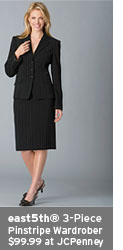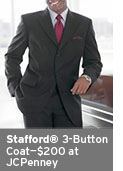Dress for Success -- for Less
You don't have to spend a lot of money to look great at work. Follow these seven tips for buying professional attire on a budget.

You've probably heard it 100 times by now: If you want to make the right impression at work, you need to dress for success. But what exactly does that mean? And how are you supposed to look successful on an entry-level salary?
Thanks to outlet malls, Overstock.com, consignment shops and designer lines at discount stores such as Target and Kohl's, there are plenty of ways to find affordable work clothes. The key is to buy the right attire so you look like a polished professional and not a junior assistant in cheap clothing.
| Row 0 - Cell 0 | How to Choose the Right Job |
| Row 1 - Cell 0 | Want to Get Rich? Get in Shape |
| Row 2 - Cell 0 | Young and Restless for Success |
A few ground rules
"Image is the first thing people notice, says Alison Doyle, the About.com guide to job searching. "What they see is what you're wearing." That's why it's crucial to project the right image if you want to get a job and get ahead. If you don't, you might not just be hurting your chances at success -- you might be killing your career.
From just $107.88 $24.99 for Kiplinger Personal Finance
Become a smarter, better informed investor. Subscribe from just $107.88 $24.99, plus get up to 4 Special Issues

Sign up for Kiplinger’s Free Newsletters
Profit and prosper with the best of expert advice on investing, taxes, retirement, personal finance and more - straight to your e-mail.
Profit and prosper with the best of expert advice - straight to your e-mail.
Follow interview attire dos and don'ts. If you're searching for an office job, be sure to dress conservatively (think coat, tie and slacks or skirt and jacket) when you meet with a prospective employer.
Cover tattoos and remove unconventional piercings if you can. Keep jewelry to a minimum. And don't were cologne or perfume. Doyle says she knows employers who won't hire anyone wearing a strong scent during an interview.
Dress for the job. Just because you're part of the working world now doesn't mean you're stuck wearing only black, blue and gray suits. Nor does it mean you can wear grungy sneakers and ripped jeans in a casual workplace.
Look at what your supervisors and co-workers are wearing, read the employee manual to see if it spells out a company dress code and do your best to look like part of the team, says Doyle. "You don't want to wear a suit if everyone's wearing khakis," Doyle says. "But if there are customers or clients coming in, you don't want to look like a slob. You still need to be neat and put together."
Don't be too trendy. Remember, you're going to work, not a fashion show. You'll impress your boss more in conservative, professional attire, and you'll get more wear out of it.
A trendy piece will stand out, making it wearable only once a week -- maybe just once a month. Besides, Doyle says, "It's more cost effective to go with a classic look than something that will be out of style next season." Flip flops, short skirts and exposed undergarments, cleavage and midriff are off limits -- even in a casual workplace.
Seven inexpensive ways to look successful
When it comes to dressing well on a budget, Kathryn Finney wrote the book -- literally. "You don't have to spend a lot of money to look great," says the 31-year-old author of How to Be a Budget Fashionista (Ballantine Books, $10.36 at Amazon.com) and creator of The Budget Fashionista blog. We interviewed Finney to get her tips:

1. Get the basics. When you're first out of college and don't have a lot of money, buy a few staples that can be mixed and matched. Finney suggests a suit that includes a skirt and pair of pants for women (guys, just stick to the pants) and two shirts. You can get up to five or six outfits with these five articles of clothing. Keep to dark or neutral colors so your colleagues won't realize you're wearing an item more than once a week. "This will get you through the first couple of months until you have money," Finney says.
2. Focus on quality. If you don't have a lot, you want to make sure what you have is good. Men can find quality, inexpensive suits at K&G Fashion Superstore, JCPenney and Target.com. For shirts and slacks, Finney recommends the Lands' End line in Sears stores, Kohl's and the Kirkland brand of shirts at Costco. Women should check out Ross Dress for Less and Target's Merona line. Both men and women will find quality threads that will fit into their budget at Marshalls, T.J.Maxx, Loehmann's, Filene's Basement and major department stores' outlet shops.
3. Determine cost per wear. Finney says most of us are used to looking at the price instead of value, which often leads us to shying away from a pricey item that will last a while and, instead, buying an inexpensive piece of clothing that will fall apart after two or three wears. "You don't need a lot of cheap stuff in your closet," she says. To determine the true value of an item, divide the price by the number of times you will wear it in a given time period (usually a year). For example, if shirt is $100 and you will wear it 20 times, it will cost $5 every time you wear it. When you're starting out, look for items that are less than $3 per wear.

4. Dry clean suits once a year. If work clothes weren't costly enough, there's the added expense of dry cleaning them. Finney says you can save money -- and your garment from damaging chemicals -- by sending your suit to the cleaners just once a year. In between, use a bottle of Febreeze. Test first on the underside, then squirt your garments down to keep them fresh and use spot treatment for stains.
5. Fake it 'til you make it. So maybe you don't have a lot of nice things in your closet, but your friends and family might. So borrow from them until you have enough money to buy your own high-end threads -- no one at work will know, Finney says.
6. Outline yourself with expensive and color in with cheap. If you're working in investment banking on Wall Street or at a law firm and need to act like you have money to look successful, you can get status symbols without paying status symbol price, Finney says. For men, it's watches, and women can achieve the look of status with a nice handbag and pair of shoes. You can snag deals on these accessories at outlet stores or online at Overstock.com. People will focus on these "expensive items" and look past your $20 pair of khakis.
7. Consider thrift stores and consignment shops. If you're on a budget, you have to think outside the box. Consignment shops are better than thrift stores because owners are more selective about the clothes they accept and sell, and you can find designer fashions there. Or check out MyGirlfriendsCloset.com, where you can buy slightly used clothing.
A final note
Finney says it's important for young people to realize there's plenty of time to get fashionable work clothing and develop their style after they've been on the job a while and know what the culture of their office is. "It's better to go safe before coming in as an ultimate fashionista," she says. Besides, you'll be more thankful if you have the basics in your closet at 6 a.m. so you don't have to worry about picking out an outfit.
Profit and prosper with the best of Kiplinger's advice on investing, taxes, retirement, personal finance and much more. Delivered daily. Enter your email in the box and click Sign Me Up.

Award-winning journalist, speaker, family finance expert, and author of Mom and Dad, We Need to Talk.
Cameron Huddleston wrote the daily "Kip Tips" column for Kiplinger.com. She joined Kiplinger in 2001 after graduating from American University with an MA in economic journalism.
-
 Small Caps Can Only Lead Stocks So High: Stock Market Today
Small Caps Can Only Lead Stocks So High: Stock Market TodayThe main U.S. equity indexes were down for the week, but small-cap stocks look as healthy as they ever have.
-
 Ask the Editor: Tips for Filing Your 1040
Ask the Editor: Tips for Filing Your 1040Ask the Editor In this week's Ask the Editor Q&A, Joy Taylor answers questions on preparing and filing your 2025 Form 1040.
-
 Is Direct Primary Care Right for Your Health Needs?
Is Direct Primary Care Right for Your Health Needs?With the direct primary care model, you pay a membership fee for more personalized medical services.
-
 9 Types of Insurance You Probably Don't Need
9 Types of Insurance You Probably Don't NeedFinancial Planning If you're paying for these types of insurance, you may be wasting your money. Here's what you need to know.
-
 Amazon Resale: Where Amazon Prime Returns Become Your Online Bargains
Amazon Resale: Where Amazon Prime Returns Become Your Online BargainsFeature Amazon Resale products may have some imperfections, but that often leads to wildly discounted prices.
-
 Roth IRA Contribution Limits for 2026
Roth IRA Contribution Limits for 2026Roth IRAs Roth IRAs allow you to save for retirement with after-tax dollars while you're working, and then withdraw those contributions and earnings tax-free when you retire. Here's a look at 2026 limits and income-based phaseouts.
-
 How to Search For Foreclosures Near You: Best Websites for Listings
How to Search For Foreclosures Near You: Best Websites for ListingsMaking Your Money Last Searching for a foreclosed home? These top-rated foreclosure websites — including free, paid and government options — can help you find listings near you.
-
 Four Tips for Renting Out Your Home on Airbnb
Four Tips for Renting Out Your Home on Airbnbreal estate Here's what you should know before listing your home on Airbnb.
-
 Five Ways to a Cheap Last-Minute Vacation
Five Ways to a Cheap Last-Minute VacationTravel It is possible to pull off a cheap last-minute vacation. Here are some tips to make it happen.
-
 How Much Life Insurance Do You Need?
How Much Life Insurance Do You Need?insurance When assessing how much life insurance you need, take a systematic approach instead of relying on rules of thumb.
-
 When Does Amazon Prime Day End in October? Everything We Know, Plus the Best Deals on Samsonite, Samsung and More
When Does Amazon Prime Day End in October? Everything We Know, Plus the Best Deals on Samsonite, Samsung and MoreAmazon Prime The Amazon Prime Big Deal Days sale ends soon. Here are the key details you need to know, plus some of our favorite deals members can shop before it's over.